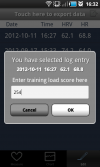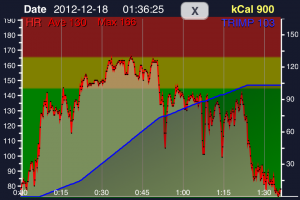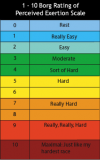 Workouts can be quantified in many ways – runners and cyclists are always being asked ‘how far did you go today’, or ‘how long were you out for’. Usually they can impress the questioner with a response like ‘I did xx miles’ or I was out for ‘x hours’. But of course simply stating the distance or time takes no account of the speed or intensity, and tells nothing of how hard you found the effort.
Workouts can be quantified in many ways – runners and cyclists are always being asked ‘how far did you go today’, or ‘how long were you out for’. Usually they can impress the questioner with a response like ‘I did xx miles’ or I was out for ‘x hours’. But of course simply stating the distance or time takes no account of the speed or intensity, and tells nothing of how hard you found the effort.
As a runner, you can do 1:30 easy talking pace and just feel refreshed at the end, or you can do a 10km race in less than half that time and feel completely exhausted at the end, with leg stiffness and cardiovascular fatigue that persists for several days.
So what’s really needed is a measure that takes into account both time and intensity in order to allow us to compare the effects of training sessions between individuals. That sounds clear enough, and surely sports scientists must have a standard way of doing this that works pretty well? Actually, no, there is no one perfect objective way of measuring training load, for the simple reason that the human body is a complex organism with multiple energy systems overlaid with hormonal signals of multiple kinds.
RPE Scale
One of the most widely used methods is not objective at all, and in fact just requires the person performing the physical work to answer a question honestly. Gunnar Borg was a psychophysiologist studying the effects of physical work and devised a scale that had verbal expressions allowing someone to point to a number between 6 and 20 that represented the total pain or effort they were perceiving. He later invented the CR10 scale which is still in widespread use today, especially in clinical & lab tests, and in speed & power sports. There is a variation, introduced by Dr Carl Foster that multiplies the effort rating by time to get a ‘Session RPE’.
TRIMP
Training IMPulse or TRIMP is not a single measurement method, but is a collection of ways of combining a relative effort and time component into a single number. TRIMP includes proprietary variants such as the Training Stress Score (TSS) created by Dr Andrew Coggan for use by cyclists training with power meters, based on a score of 100 for a 1 hr maximum sustained effort. This is also used in the Training Peaks software. An intensity factor (IF) is then used for power (effort) levels higher or lower than this.
Most TRIMP calculations are based on Heart Rate measurements over the course of a workout, since increasing HR reflects increasing effort. Although heart rate is easy enough to measure continuously using a wireless HRM chest strap (or perhaps optical sensors), it has two characteristics that need to be understood in order to use it effectively:
- Individuality. The relative effort of one person vs. another at the same heart rate can vary widely. A 16 year old soccer player might get their heart to 170 bpm with ease, whereas an older, less fit person would struggle to achieve this even with maximum effort.
- Delayed response. When effort level increases suddenly, the sympathetic branch of the nervous system stimulates production of adrenaline (epinephrine) but it might be 30s before the heart rate is stable at the new level. Similarly, when effort levels fall, heart rate also has a delayed response. This makes TRIMP calculations based on average heart-rate (such as Banister TRIMP) less useful than ones that use dynamic values. There is still no good solution for this characteristic, making heart-rate less useful for sports and workouts that involve short bursts of very intense activity.
To handle individuality, there are a couple of methods that are useful. The best involves an individual calibration of blood lactate against heart rate (iTRIMP, Abt, Akubat, Manzi) but this requires lab testing not available to most non-professional athletes and team sports players.
Lucia proposed a category version of TRIMP, where time at a heart rate below the individual’s first lactate threshold would be given 1 point per minute, time above the 2nd lactate threshold 3 points per minute, and time in between the two thresholds 2 points per minute. Although not fully individualised, this method has the advantage that the thresholds can be reasonably well estimated using the person’s age and fitness level. The first threshold can be estimated using Dr Phil Maffetone’s 180 Formula. The second threshold (at which breathing becomes ragged & uncontrolled) can usually be found between 85-90% of the maximum heart rate. Carl Foster has recently published work to show that these thresholds can be estimated quite well using breathing tests that anyone can perform during a graded workout.
Precision Pulse
The Lucia TRIMP method is the one we have implemented in the Precision Pulse Heart Rate Monitor (HRM) app. All the user has to do is fill out the Settings screen as accurately as they can. Knowing the true maximum HR and being honest with the fitness level setting will help a lot!
The chart below shows an example workout where the TRIMP score can be seen as the blue line, whose slope changes according to the intensity at a particular time. The accumulated total for this workout is 103, as shown in the top right of the screen. The background colours show the region; below first lactate threshold (green), above 2nd threshold (red) and in between (yellow). When the workout has finished (after 1:25), the heart rate falls, and no more TRIMP points are accumulated.

ithlete Precision Pulse is a precision heart rate monitor app for iPhone, iPod Touch and iPad that works with analog HRM chest straps and allows you to use GPS run & cycle tracking apps & listen to iPod music all at the same time. To read more about Precision Pulse features or the required hardware why not visit our product page?


What do you think of EPOC (Firstbeat Athlete) measurements for training load?
Surely there is a strong correlation between calories burned & training load. Would this not be an easy, more objective way to measure training load. My old HRM used to give me a value but my new one doesn’t … so I’m a bit lost.
Hi Sonja,
Yes, in general, sessions with a higher training load will burn more Calories, but there is a significant subtlety : whereas kCal per minute rises linearly with exercise intensity, training load moves exponentially, following the lactate curve, so HIT sessions are under-represented on kCal during exercise (although as another subtlety, post exercise kCal burn EPOC is higher for intensive sessions!).
If in need of a simple measure, you can do a lot worse than the 10 point RPE scale – its used by a large number of professional track & ball sports athletes, and we provide the prompts for levels within ithlete when you tap the TL box.
Hope this helps.
I do not think that this applies to running. When running you spend more or less the same amount of calories per kilometer no matter how fast you run.
Hi Lazaros. That’s interesting. Do you have a reference where this has been researched?
There isn’t a lot of mystery in TRIMP, it’s simply Duration X Intensity, normalized to a “human” number. For example in SportTracks we allow a maximum of 2 points per minute of exercise (120 per hour), and call “Effort”, which is a more comprehensible description for mere mortals than these word-soup acronym-ized phrases like “TSS”.
So, the “special sauce” comes in measuring intensity. With modern sensors we have an array of data we can use, recorded at per-second sampling. The most obvious ones being a) heart rate, b) power (cyclists), and c) pace. So now you’ve got a data stream of the workout, and you can calculate the per-second intensity.
To address your two concerns:
1. Individuality. This is handled by the athlete defining min/max parameters, and possibly intensity zones in the software. These should be generated by a threshold test. You can get this done in a performance lab, or you can approximate it DIY. Depends on your budget and seriousness. ** It is incumbent on the athlete to periodically measure their threshold during periods of intense training, and adjust the software parameters **
2. Response delay. It’s possible to handle this by shifting the analysis window during per-second calculations. But since this data is aggregated to a single Effort value, it’s not really adding any precision (or maybe you toss the first 30 seconds… meh). Consider that for a 1 hour workout, 30 seconds would be less than <1%, and it's not likely your intensity will vary much more than 10-35%. So we're talking about a tiny fraction of typical training endurance workouts.
I don't know of any "serious" software that's using average heart rate to calculate intensity. Sure, it can be used as a fallback for manually entered workouts, as can RPE if you don't wear a HRM, but in 2016, for serious athletes, we've kind of moved beyond this.
You can read more about the exact calculations we use for TRIMP in SportTracks on our website, along with more of the background theory: https://www.sporttracks.mobi/blog/training-load-science-history-and-application
Hi Aaron,
Thanks for the comment & references. Having studied training load a little, I think it is still a challenging area and although we have good technology such as power meters and GPS to quantify external load, we are far from understanding all the contributions to internal loading. iTRIMP provides an individual lactate based calibration, which is an advance but requires a ramped lab test. I’m also far from convinced that intensity (however obtained) should be linearly multiplied by time. I think that HRV & EPOC based measurements such as described here http://www.myithlete.com/can-hrv-be-used-as-a-more-accurate-individualized-measure-of-training-load/ have some potential.
Chris : HRV measured EPOC is very well backed by many studies as a very precise non-invasive lactate level estimation. ( No needle + during the exercise / on the fly measure ! ) ( Much more simple…and cheaper than muscle oxygen saturation (SmO₂) devices Moxy / BSX )
It’s been my objective – therefore trusted – tool for the last five years.
However a few day ago I did a long 15 ml/kg (yes …I’m a CFS sufferer ) effort that left me maybe more tired than the 96 I did the day before. On reading the comment of Simon to Sonja I decided to let go of a life time of reliance on objective numbers to venture myself in subjective estimation.
To this day subjective seems more efficient than objective. EPOC + TIME still is what – through FB Athlete- I use for evaluating the effort to come but for the done effort I am – now – a believer in 1-10 RPE .